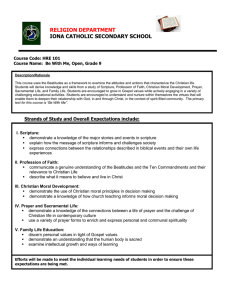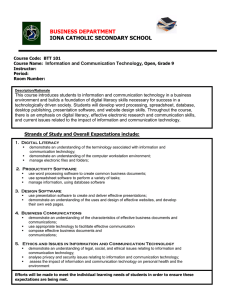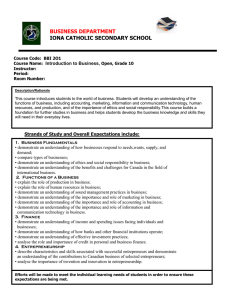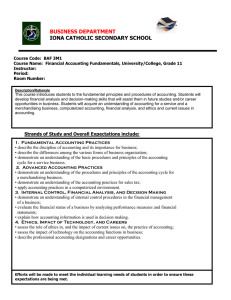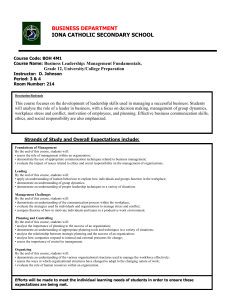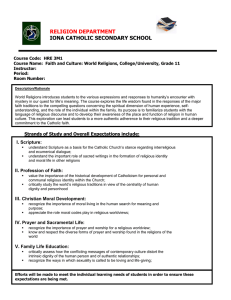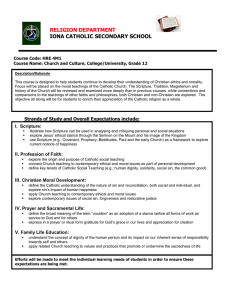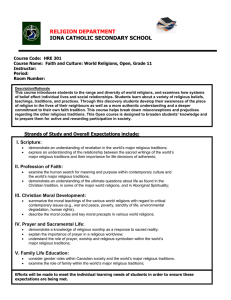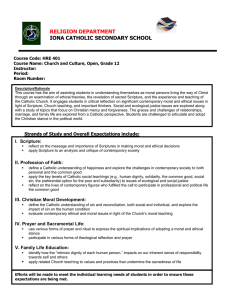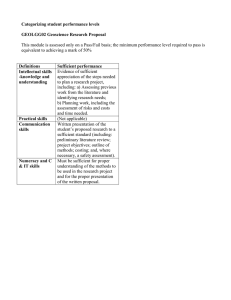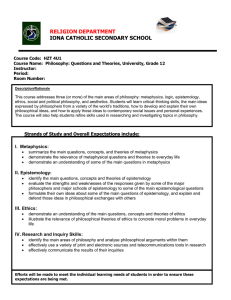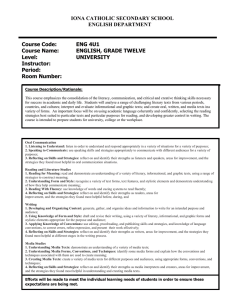IONA CATHOLIC SECONDARY SCHOOL RELIGION DEPARTMENT Course Code: HRE 201
advertisement
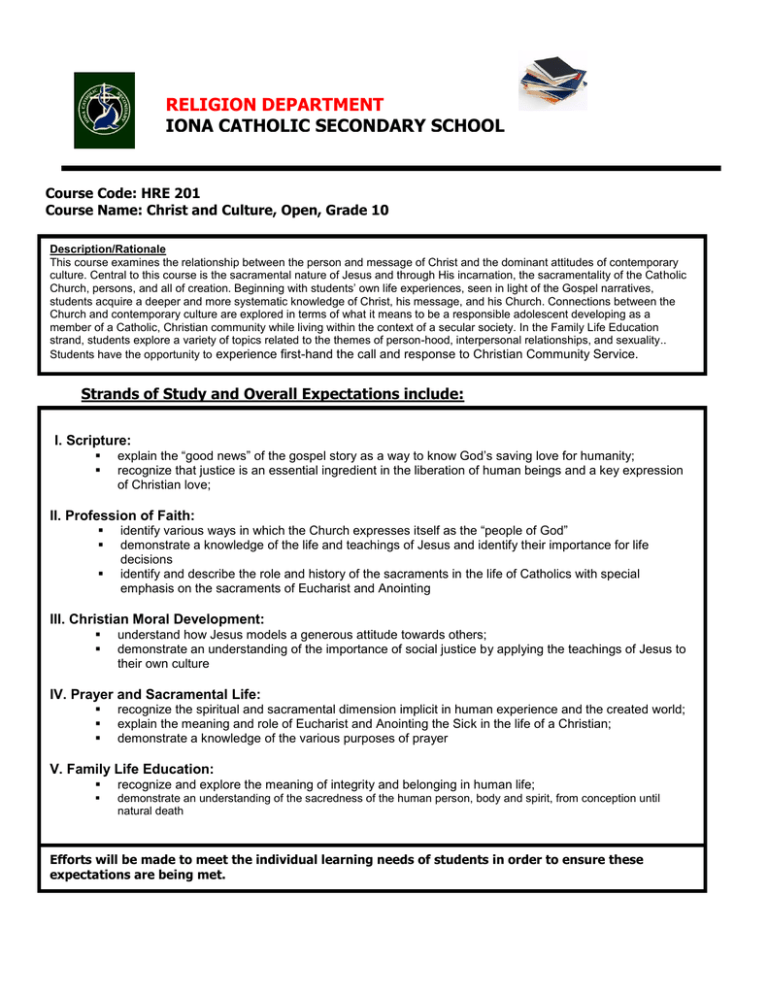
RELIGION DEPARTMENT IONA CATHOLIC SECONDARY SCHOOL Course Code: HRE 201 Course Name: Christ and Culture, Open, Grade 10 Description/Rationale This course examines the relationship between the person and message of Christ and the dominant attitudes of contemporary culture. Central to this course is the sacramental nature of Jesus and through His incarnation, the sacramentality of the Catholic Church, persons, and all of creation. Beginning with students’ own life experiences, seen in light of the Gospel narratives, Strands of Study and Overall Expectations include: students acquire a deeper and more systematic knowledge of Christ, his message, and his Church. Connections between the Church and contemporary culture are explored in terms of what it means to be a responsible adolescent developing as a member of a Catholic, Christian community while living within the context of a secular society. In the Family Life Education strand, students explore a variety of topics related to the themes of person-hood, interpersonal relationships, and sexuality.. Students have the opportunity to experience first-hand the call and response to Christian Community Service. Strands of Study and Overall Expectations include: I. Scripture: explain the “good news” of the gospel story as a way to know God’s saving love for humanity; recognize that justice is an essential ingredient in the liberation of human beings and a key expression of Christian love; II. Profession of Faith: identify various ways in which the Church expresses itself as the “people of God” demonstrate a knowledge of the life and teachings of Jesus and identify their importance for life decisions identify and describe the role and history of the sacraments in the life of Catholics with special emphasis on the sacraments of Eucharist and Anointing III. Christian Moral Development: understand how Jesus models a generous attitude towards others; demonstrate an understanding of the importance of social justice by applying the teachings of Jesus to their own culture IV. Prayer and Sacramental Life: recognize the spiritual and sacramental dimension implicit in human experience and the created world; explain the meaning and role of Eucharist and Anointing the Sick in the life of a Christian; demonstrate a knowledge of the various purposes of prayer V. Family Life Education: recognize and explore the meaning of integrity and belonging in human life; demonstrate an understanding of the sacredness of the human person, body and spirit, from conception until natural death Efforts will be made to meet the individual learning needs of students in order to ensure these expectations are being met. Course Breakdown UNITS OF STUDY: Unit 1 – To Be Human Is...? Unit 2 – Who has Culture? TEXTS AND RESOURCES: Bible “Christ and Culture” Unit 4 – The God Question Unit 5 – Relating to the Other Unit 6 – Relating to Civil Society Resources: The course will use a variety of resources including video, CD-ROM, Internet Applications and a variety of print sources. The textbook will be distributed to students during the first week of the course. The text and all other resources assigned to students are the responsibility of the student. Any damage incurred will result in payment for replacement. Replacement cost for the text will be posted in the classroom. Evaluation Structure: Knowledge/Understanding Thinking Communication Application 25% 25% 25% 25% These are assessed in both term work and summative work as follows: TERM WORK - 70% SUMMATIVE WORK – 30% Culminating Task – 10% + Final Exam – 20% Unit 7- Relating to the Church Evaluation Policy Students will be assessed & evaluated according to the work produced & skills displayed. Methods of providing feedback will include assessing work in process & evaluating completed assignments, tests, co-operative learning activities, simulations and presentations. Student marks will be determined by evaluating process & product according to 4 categories & 4 levels. Please see the chart below for specific skills and key words used to determine student competency in the different categories. Category Knowledge/Understanding: Knowledge of facts & terms Understanding of concepts & relationships Thinking: Critical thinking skills Creative thinking skills Inquiry Skills Communication: Communication of ideas and information Use of symbols & visuals Oral & written communication Application: Level 1: Level 2: Level 3: Level 4: 50-59% 60-69% 70-79% 80-100% Limited display of: Some success in: -knowledge and understanding -knowledge and understanding -critical and creative thinking skills and/or processes -critical and creative thinking skills and/or processes -conveying of meaning through various forms -conveying of meaning through various forms -knowledge and skills to make connections between various contexts -knowledge and skills to make connections between various contexts Considerable display of: -knowledge and understanding Thorough understanding of: -knowledge and understanding -critical and creative thinking skills and/or processes -critical and creative thinking skills and/or processes -conveying of meaning through various forms -conveying of meaning through various forms -knowledge and skills to make connections between various contexts -knowledge and skills to make connections between various contexts Applications in familiar contexts Transfer of concepts to new contexts Making logical conclusions and predictions Use of technology Feedback will also be provided for student learning skills. Skills like working independently, team work, organization, work habits and homework, and initiative are assessed independently student achievement and will be conducted through the use of a rubric indicating specific criteria to be achieved to receive each of the following letter grades: E –Excellent G – Good S – Satisfactory N - Needs Improvement Other Evaluation Issues LATE ASSIGNMENTS The due dates for major assignments will be clearly articulated by the teacher when the task is assigned. The teacher will establish a deadline and an acceptance period of 3 school days following the deadline. The teacher will also allow for submission of assignments before the deadlines of the acceptance period for the purpose of assistance in revising. If a student does not hand in the assignment by the deadline, a mark reduction will be applied to the assignment submitted thereafter up to a total of 10%. If the assignment is not submitted by the end of the acceptance period the student will receive a mark of zero. Refer to the Student Handbook for further details. INCOMPLETE ASSSIGNMENTS Assignments will be graded according to the extent with which they meet the criteria established in the rubric or evaluation structure. MISSED TESTS. Teachers will give the class ample notice for up-coming tests/evaluations. It is the responsibility of the student to make arrangements for an alternative assessment date (which may not be during class time) with the teacher before the scheduled time for the test/evaluation. If a test is missed due to a legitimate reason, verification (note only to be handed in on the day of the student’s return) from a parent/guardian must be given to the subject teacher indicating that the parents are aware the student has missed a test. If a test is missed as a result of truancy, a mark of zero will be assigned with no opportunity for a re-write. PLAGIARISM in any form reflects academic dishonesty and will result in a mark of zero for the assignment in question. Refer to the Student Handbook for further details. ATTENDANCE It is the responsibility of each student to be punctual and in attendance, with proper materials, at all classes and scheduled activities. Students who miss classes may put their credit in jeopardy. It is the student’s responsibility to catch up on missed work when absent.
